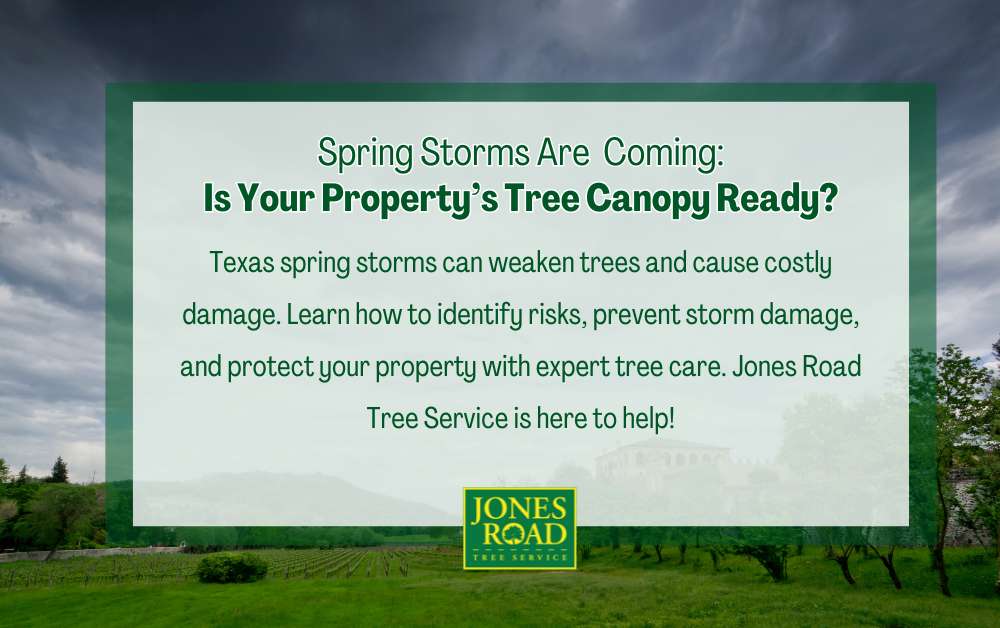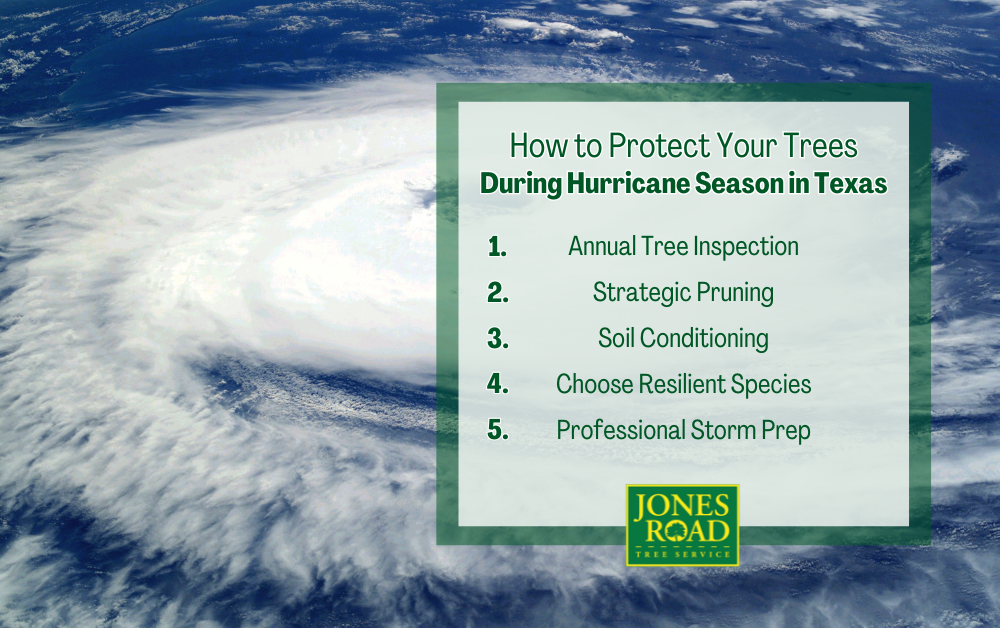Spring storms in Texas bring high winds, heavy rain, and the potential for severe weather, making trees vulnerable to damage. Weak or overgrown limbs can break, causing costly damage to homes, vehicles, and power lines. Preparing your trees now can help prevent these risks. In this guide, we’ll cover how to assess tree health, reduce storm damage, and protect your property before the next big storm hits.
How Spring Storms Affect Trees
Texas’ spring storm season is known for its strong winds, heavy rain, hail, and even tornadoes, all of which pose a serious threat to trees. High winds can snap weak branches, heavy rain can soften the soil, leading to uprooted trees, and hail can damage bark and leaves, making trees more susceptible to disease.
Each year, severe weather causes millions of dollars in property damage due to falling trees and broken limbs. According to the National Weather Service, Texas experiences an average of 137 tornadoes per year. During storms, trees that are poorly maintained or already weakened are most at risk of falling on homes, vehicles, and power lines, leading to costly repairs and dangerous situations.
Understanding how storms impact trees is the first step in preventing damage. By identifying and addressing weak spots before severe weather strikes, homeowners can reduce the risk of fallen trees and protect their property.
How to Identify Weak or Hazardous Tree Limbs
Before storm season hits, it’s important to inspect your trees for weak or hazardous limbs that could break under high winds or heavy rain. Here’s what to look for:
Visual Signs of Weak Branches
- Cracks, splits, or peeling bark – These indicate structural weakness and increase the risk of breakage.
- Dead or diseased limbs – If a branch lacks leaves in the growing season or has fungi growing on it, it may be dead or decaying.
- Overextended or heavy limbs – Large branches extending far from the trunk can be weighed down and more likely to snap.
- Branches with previous storm damage – Limbs that were weakened in past storms may break off completely in the next strong wind.
Warning Signs in Tree Trunks and Roots
- Hollow or rotting areas in the trunk – Decay weakens the tree’s core, making it more likely to fall.
- Leaning trees with exposed roots – Trees that are suddenly leaning or have visible roots may be losing stability.
- Fungal growth at the base of the tree – Mushrooms or fungi indicate internal decay, which can compromise the tree’s strength.
If you notice any of these warning signs, it’s best to contact a certified arborist for a professional tree risk assessment. An expert can determine whether pruning, cabling, or even tree removal is necessary to prevent potential storm damage. Investing in preventative care now can save you from costly repairs later.
Preventing Storm Damage to Your Trees
Taking preventative measures before Texas’ spring storms hit can help reduce the risk of tree-related damage. By pruning weak limbs, stabilizing vulnerable trees, and maintaining overall tree health, homeowners can ensure their trees withstand severe weather.
Pruning for Safety and Stability
- Remove weak, dead, or overgrown branches before storm season to prevent breakage.
- Proper pruning improves airflow and weight distribution, reducing wind resistance.
- Avoid over-pruning, which can weaken the tree’s structure—hire a professional arborist to ensure safe trimming.
Cabling and Bracing for Weak Trees
- Support systems, like cables and braces, help stabilize mature or structurally compromised trees.
- These reinforcements prevent large limbs from splitting under strong winds.
- If a tree has multiple trunks or large overhanging branches, an arborist may recommend cabling or bracing to strengthen it.
Healthy Tree Maintenance to Strengthen Storm Resistance
- Deep root fertilization encourages stronger roots, helping trees anchor more firmly in the ground.
- Proper watering—especially in drought-prone Texas—keeps trees resilient and prevents dry, brittle limbs from snapping.
- Applying mulch around the base can help retain moisture and protect roots from soil erosion during heavy rains.
Taking these steps now can help prevent costly damage later. If you’re unsure about your tree’s storm readiness, a professional tree service can assess and prepare your trees before severe weather strikes.
Protecting Your Property from Falling Trees
While proper tree maintenance can reduce the risk of storm damage, it’s also essential to consider how trees are positioned around your home and other structures. Identifying potential hazards in advance can help prevent costly damage and safety risks.
Assess Tree Placement Around Structures
- Inspect trees that are too close to homes, garages, driveways, or power lines—strong winds can send branches or entire trees crashing down.
- Look for overhanging limbs that could fall onto roofs or vehicles.
- If a tree is significantly weakened or leaning toward a structure, removal may be necessary to prevent future damage.
What to Do If a Tree Falls During a Storm
- Stay inside and avoid going near fallen trees, especially if power lines are involved.
- If a tree damages your home or blocks access to your property, contact an emergency tree removal service immediately.
- Never attempt to remove large fallen trees or branches on your own—professional arborists have the equipment and expertise to handle dangerous situations safely.
Homeowner Insurance and Storm Damage Coverage
- Many home insurance policies cover damage caused by fallen trees if it results from a storm or natural disaster.
- Coverage typically includes tree removal costs and repairs to homes, fences, and driveways affected by tree damage.
- Check your policy details to understand what’s covered and contact your insurance provider if you experience storm-related tree damage.
Taking proactive steps now can protect your home, property, and family from the dangers of falling trees. If you’re unsure about your trees’ safety, consider scheduling a professional tree risk assessment before storm season begins.
Get Your Trees Storm-Ready Before It’s Too Late
Spring storms in Texas can bring high winds, heavy rain, and severe weather, posing a serious risk to trees and property. Identifying weak limbs, pruning for stability, and ensuring proper tree maintenance can help prevent costly damage and dangerous situations. By taking proactive measures now, homeowners can protect their trees and reduce the risk of fallen branches or uprooted trees during storms.
Don’t wait until it’s too late! Schedule a professional tree risk assessment with Jones Road Tree Service today. Our certified arborists provide expert pruning, tree stabilization, and storm preparation services to keep your property safe all season long. Contact us now to book your consultation and get your trees storm-ready!





